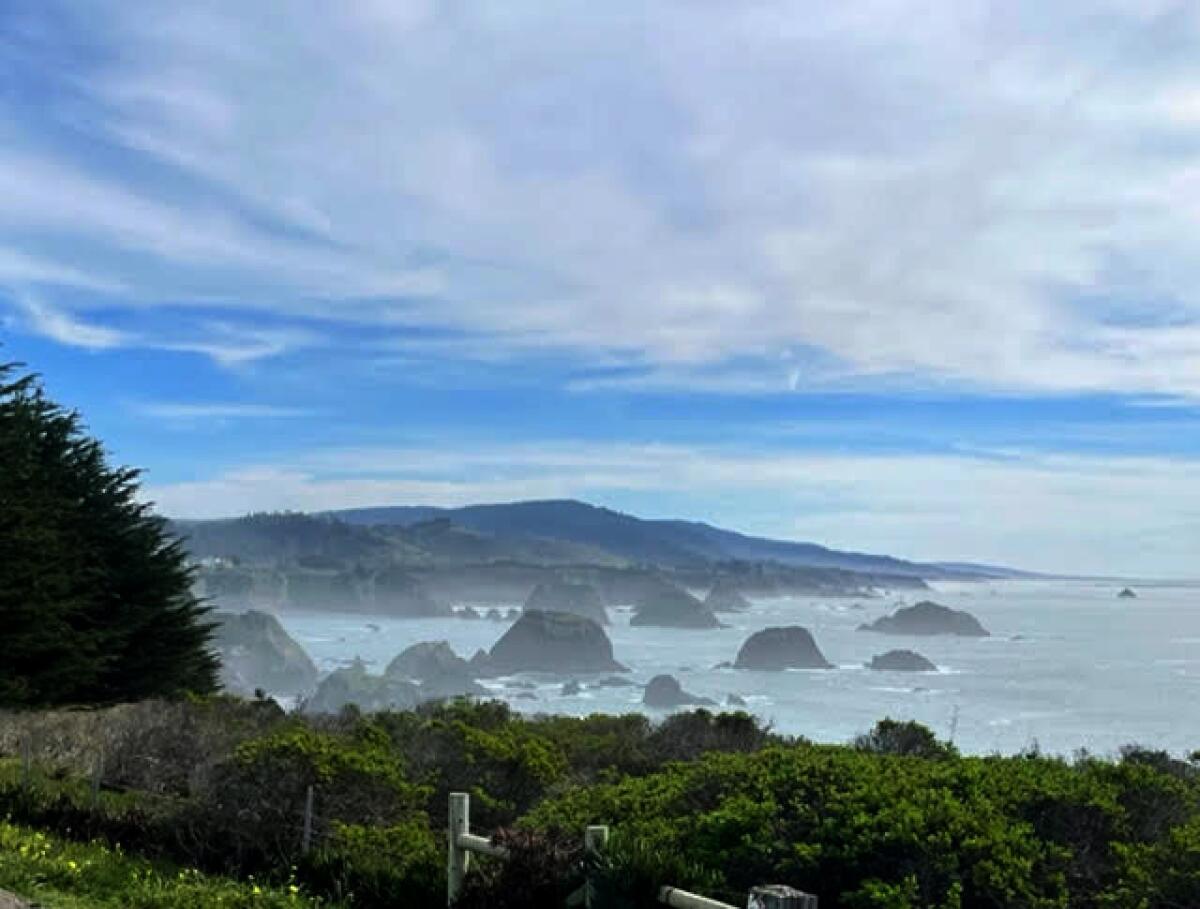How Korean Americans shaped K-pop, and vice versa

- Share via
Good morning, and welcome to the Essential California newsletter. It’s Wednesday, March 29. I’m Jeong Park, a reporter covering Asian American communities for The Times, coming from Mid-City.
When I introduce myself and say what I do for a living, people have asked me: Do you cover K-pop?
No, I don’t — or at least not in a way you would expect. I’m not writing about the latest albums or reviewing concerts.
Still, I’ve found myself putting K-Pop references into many stories, from one on the rebirth of Koreatown to another on Korean Americans’ mental health. For many Asian Americans like me, K-pop is a big part of our identity and how we live.
“K-Pop Dreaming,” a recently launched podcast from LAist Studios, explores that dynamic, looking at how Korean Americans shaped the genre, and vice versa.
Vivian Yoon, a 2.5-generation Korean American writer and actor, hosts the podcast. She grew up in Koreatown, where K-pop has long been a staple in grocery stores and restaurants.
“You can’t escape the music when you’re growing up with it,” she said.
The podcast looks at the evolution of K-pop from Trot, a music genre that emerged from the Japanese colonization of Korea. It also looks at events such as the 1992 L.A. riots, and how Korean rapper Tiger JK played a role in promoting interethnic harmony in the aftermath.
I spoke with Yoon as she wrapped up an episode of the podcast. The interview is edited for length and clarity.
You said you used to hide your love of K-pop because you wanted to look different from a typical Korean girl. What did you mean by that?
Yoon: Nobody was making fun of me for listening to K-pop. But that internal shame came out of a sense of really wanting to be seen as an American. A lot of that came from the fact that my dad grew up in the States, and he served in the Army. He was a self-proclaimed “Twinkie,” where he’s yellow on the outside and white on the inside.
My dad was my hero, and my dad was the most American Korean person I knew, and that’s what I saw that made him so different. That really was what I wanted for me, too.
How did Korean Americans shape K-pop?
Korean Americans from L.A. were bringing Black American music and culture from Los Angeles to Korea. Korean American kids who spoke both languages ... helped Koreans access Black American music and culture in a way that was maybe seen as more authentic than Korean locals who had never been to the U.S.
As those Korean American kids from L.A. joined first-generation groups, they totally influenced the sound, the style, the swagger.
How did K-pop shape Korean Americans? Koreatown?
I can only really talk maybe about my own experience … where the music represented the side of me that American music couldn’t access. Korean music hit a certain spot that American music just didn’t.
[In a future podcast episode], we also talk about how businesses and the landscape of K-Town have changed because of K-pop. There’s this music store inside Galleria [shopping mall], and when it opened in the early 2000s, they were selling American albums because the clientele was older Korean people who wanted Elvis or Michael Jackson CDs.
But over time, gradually, more non-Korean K-pop fans started going to the store and asking for certain albums or merchandise. That’s when the two brothers who owned it decided slowly to shift their inventory … until eventually, by 2016, they were all-in on K-pop. Places like that, you see how the organic growth of Hallyu [the Korean Wave] has really shaped actual businesses and the economy of K-Town.
You’ve also looked at how Korean American acts navigate being seen as foreigners in Korea.
When we were talking to [Korean American R&B group] Solid, they said, ‘We were obviously not from Korea, and it showed,’ because when they sang and they rapped, they had an accent or they dressed differently. For them, it was important for them to maintain their identity as Korean Americans from L.A. County and not necessarily trying to assimilate because they had their own sense of what was cool or what was interesting to them, and they really stuck to that.
You’ve said that in the course of working on this podcast, you’ve learned a lot about your own family. What was that like for you?
It allowed me to answer some questions that I had about my own identity. And it allowed me to see that as Korean Americans, we don’t have to be fully Korean, and I don’t have to be fully American. And if there is no space for our stories in either camp, we make that space to tell our stories and to preserve our history and to understand ourselves. Understanding how special that, as Asian Americans, we can occupy this third space — that was surprisingly powerful for me.
Yoon’s favorite K-pop song at the moment? “Ditto” by NewJeans. (And if you’re curious, my favorite is “Vibe” by Taeyang feat. Jimin of BTS.)

For more K-pop reports from The Times, check out the following:
- Every weekend, the internet’s biggest K-pop fans swarm L.A. cafes
- K-pop act Twice draws swarms of fans during pop-up appearance on Melrose
- K-Pop isn’t the only hot ticket in Koreatown — how ‘trot’ is captivating immigrants
And now, here’s what’s happening across California:
Note: Some of the sites we link to may limit the number of stories you can access without subscribing.
Tulare Lake in Kings County reemerges. This month, powerful storms led to rivers swollen with runoff and flowing full from the Sierra Nevada into the valley. Los Angeles Times
Is it a new type of homeownership or just a party house? Newport Beach is grasping with the rise of fractional ownership, in which multiple people own a small share of a luxury single-family residence that they use as a vacation property. Los Angeles Times
Silicon Valley Bank is bought, but Silicon Valley is moving on. Chase, Wells Fargo, Bank of America and Citi are the “big beneficiaries” of Silicon Valley Bank’s demise, said a banking analyst. Mercury News
L.A. STORIES
Twitter suspends the account of an anti-police website. An LAPD union sued the owner of the website for offering a “bounty” for the killing of police officers. Los Angeles Times
Altadena mural sparks debate. The artist wants people to see the mural, depicting figures with weapons wrestling, and “look within themselves and reflect on their own actions.” But some residents see it as promoting violence. San Gabriel Valley Tribune
Not more rain! Alas, another storm moved into California on Tuesday. It will make its way south and east through Wednesday. Los Angeles Times
Check out "The Times" podcast for essential news and more
These days, waking up to current events can be, well, daunting. If you’re seeking a more balanced news diet, “The Times” podcast is for you. Gustavo Arellano, along with a diverse set of reporters from the award-winning L.A. Times newsroom, delivers the most interesting stories from the Los Angeles Times every Monday, Wednesday and Friday. Listen and subscribe wherever you get your podcasts.
POLITICS AND GOVERNMENT
Berkeley Unified looks at reparations to Black students. The district is creating a task force that will bring recommendations to the school board by January. San Francisco Chronicle
Homeless success story out of Sacramento? The number of homeless people sleeping outdoors in downtown Sacramento has decreased by 40% in the past five months, according to a monthly census. Sacramento Bee
East West Bank’s CEO fights disloyalty attacks from the right. Dominic Ng and Congresswoman Judy Chu are among several Southern California Chinese Americans targeted by conservative officials. Friends are defending Ng. “There could not be a more loyal American than Dominic Ng,” a former commerce secretary said. LAist
CRIME, COURTS AND POLICING
Interviews of family members of those shot by police are used to protect the officers and their department. The investigation by The Times and the Investigative Reporting Program at UC Berkeley’s Graduate School of Journalism found 20 instances of the practice by 15 agencies across the state since 2008. Los Angeles Times
San Francisco attorneys say street-level drug dealers are human trafficking victims. Juries were divided over whether the defendants were criminals or victims, leading to mistrials in two cases. San Francisco Chronicle
Straight out of “Grand Theft Auto”? A man who allegedly stole a California Highway Patrol cruiser jumped out of the driver’s side door onto Highway 138 near Lancaster. Los Angeles Times
Support our journalism
HEALTH AND THE ENVIRONMENT
Saddleback Wilderness gets trails. Some 3.3 miles of trails have opened near Irvine Lake in Orange County. The area was once used for a “motor playground” by motocross riders, but 40 years after its closure, the land was left to return to its natural state. Orange County Register
A 19,333-unit project near the Grapevine may be dead. Los Angeles Superior Court judge ordered the project’s approval rescinded, finding that the county review does not comply with (what else?) the California Environmental Quality Act. Bakersfield Californian
CALIFORNIA CULTURE
Rest in peace, the king of xiao long bao. Bing-Yi Yang, who founded Din Tai Fung, died at the age of 96. Los Angeles Times
Disney wants to build a master-planned community in Riverside County. Think “Incredibles 2.” Los Angeles Times
Tyre Nichols Skate Park comes to Sacramento. The City Council approved the naming of a North Natomas skate park after Nichols, who grew up in Sacramento. Sacramento Bee
Free online games
Get our free daily crossword puzzle, sudoku, word search and arcade games in our new game center at latimes.com/games.
AND FINALLY
Today’s California landmark is from Dan Rothermel of York, Maine: The coastline along Elk in Mendocino County.

In the winter of 2022, my wife, Hannah, and I visited our friends Tree and Scott Mercer in Gualala, Calif. On the way back from our hike in the Van Damme State Park in Mendocino County, we pulled to the side of the Pacific Coast Highway to be in the presence of the Sacred Rocks.
— Dan Rothermel
What are California’s essential landmarks? Fill out this form to send us your photos of a special spot in California — natural or human-made. Tell us why it’s interesting and what makes it a symbol of life in the Golden State. Please be sure to include only photos taken directly by you. Your submission could be featured in a future edition of the newsletter.
Please let us know what we can do to make this newsletter more useful to you. Send comments to essentialcalifornia@latimes.com.
Sign up for Essential California
The most important California stories and recommendations in your inbox every morning.
You may occasionally receive promotional content from the Los Angeles Times.




